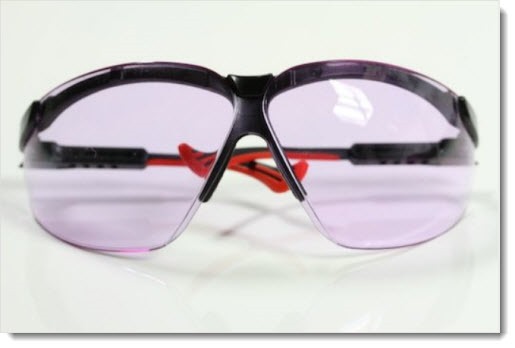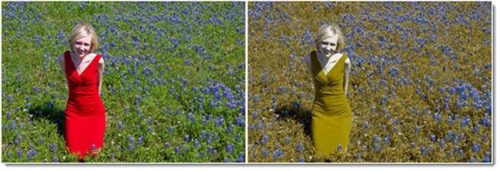(UPDATE: There’s updated and more accurate information in this 2024 article. In 2013 I used the word “cure” but that’s not the right term. Read the 2024 article for a clearer perspective.)
These two photos look identical to me.
This isn’t about computers, but indulge me for a moment. This is extraordinary technology and might be as important for some of you as it is for me.
Eight percent of men are red-green colorblind. (Almost no women. It’s a genetic thing.) It’s hard to describe, because my world has a full spectrum of colors – “colorblind” does not mean the world is grey. But as you can tell by looking at those photos, I’m not seeing the same colors you are. There are more examples here.
The lenses on Oxy-Iso glasses cure red-green colorblindness for some people. When I wear my pair of Oxy-Iso glasses, I can see the colors in your world for the first time in my life.
The researchers at 2 A I developed three lenses for the medical profession for clearer views of veins, blood oxygen level, bruising, flushing, and other blood physiology. The lenses adjust the color signals hitting the eyes in different ways.
The cure for colorblindness in Oxy-Iso lenses is a side effect, not the intended purpose. The company does not promise results, and there are some variations of red-green colorblindness that do not respond to the glasses. David Pogue tried them and they didn’t help his severe Protanopia. (He just found some more expensive glasses that work for him.) I’ve got another type of red-green colorblindness, Deuteranopia, and the glasses work perfectly for me and many people, as you’ll see in the enthusiastic reviews on Amazon.
The Ishihara test is the standard test for colorblindness – circles with packed blobs that form numbers that are visible to people with normal vision. I scored 0 out of 8 on this online version of the Ishihara test.
I put on the glasses for the first time in front of the computer and immediately scored 8 out of 8 on the test.
Since then I’ve been walking outside – the glasses are better in bright light – and seeing a different world. Reds are completely different than I thought, lighter and brighter, not the dark brownish tint that I normally see. Red leaves pop out on the trees as they change color. The unripe blackberries jump out at me. Fire trucks and red cars look cool.
It took me a while to realize that an even more profound change was happening to the greens. See the difference in the color of the grass and bushes in the background of the above picture? Words can’t express how it feels to look at trees, put the glasses on, see the leaves change to a completely different color, barely resembling the uncorrected view – while other colors are unchanged!
I walk by an apple orchard with Gravenstein apples. Without the glasses, I see the trees. When I put on the glasses, the trees are suddenly covered with apples, a whole hillside of trees loaded with fruit that I can’t see unaided. But these aren’t red apples! The apples don’t change color. The trees change color and the apples become visible against them.
It’s hard to describe. Greens and reds are richer, yes, but they’re also shifting hues in ways that make them more varied and more interesting, bringing out contrasts that I had no idea were there. It’s emotional and at times breathtaking. I may not wear them all the time forever but I’m learning lessons that will help me understand my unaided vision.
The glasses aren’t designed for full-time use but I’ve found them comfortable to wear for several hours, with no distortion or tiring. The purple tinting is a bit noticeable in low light or under artificial lights and disappears in bright light.
This article by one of the lens developers has a wealth of information about the science of the lenses and the strengths and limitations of the color correction. “The Oxy-Iso filter amplifies the red-green discriminations color-deficients are lacking, but does so at the expense of their intact color perception and yellow-blue discrimination. In a sense, the Oxy-Iso spreads the color confusion more evenly around the color-wheel, rather than having it concentrated only on red-green.” Personally I haven’t noticed any diminution of yellows and blues.
This Popular Science article has more background information, and is typical of the enthusiastic coverage that the lenses got earlier this year when the word got out. Now the company is reportedly talking to Oakley and Ray-Ban to put the technology into sunglasses and designer frames.
You don’t have to wait. The glasses can be purchased from Amazon for $300.
If those two photos look the same to you, start doing some research on the Oxy-Iso glasses! The world is colorful in a way that you might be able to see for the first time.




I feel really bad for people who fall for this. It does not and cannot allow you to see new colors. Period. It’s science. Your eyes are missing certain cone receptors that translate that color (e.g. red) to your brain. NOTHING you do on the outside of your eyes will change this. What these glasses do is expand the contrast of the colors you can already see, and make them stand out from each other. That’s all. You aren’t seeing new colors and you definitely aren’t seein what the rest of us see. That being said, a cure to color blindness WAS discovered and successfully performed on monkeys. For whatever reason, the company never moved on to human trials. What they do is take the DNA strands from a normal eye and inject them into a colorblind eye. And it works. Hoping someday they finally allow it for humans. Until then, please don’t allow these glasses companies to fool you.
You’re both technically more or less correct – and you’re missing the point. You say that “what these glasses do is expand the contrast of the colors you can already see, and make them stand out from each other.” I have years of experience now, both with the Oxy-Iso glasses (now marketed by Vino Optics) and with EnChroma lenses, which are not effective for me but are effective for others, so I’m in a good position to tell you that the difference can be profound, life-changing, and yes, amazing.
Your objection is that it’s inaccurate to use the word “cure.” I’m not sure I agree but I don’t think it’s important – because this is far more than companies seeking to “fool us.” My brain believes it saw red leaves in New Hampshire. That’s important, important enough to stir me to tears, even if you don’t think my “red” is the same as your red.
The oxy-iso glasses change the impressiopn of colors. But you will not know what color you are looking at. The only working aid for a color blind peson is still the Seekey. http://www.seekey.se/
TREATMENT OF COLOUR BLINDNESS IN 1 DAY
Are you Colour Blind?
Has your color blindness been an obstacle for your career in the military, law enforcement, coast guard or other field? If so, you’re in luck! The Memory Guru of India has created the Brain Mapping System™ to help you pursue your passion and dreams.
Get Color Blindness Treatment
Color Perception and Employment
Some jobs require color perception. For example, electrical wiring is often color-coded, and the aviation field uses color-coded lights for various functions. People who are colorblind may find their employment options limited if they are seeking a career in a field such as the military, law enforcement, or Coast Guard services. Other professions that may not be available to colorblind individuals are firefighting, engineering, pilots, or becoming a railroad engineer.
Safety standards in these fields require that applicants must be able to pass the Ishihara Color Plate Test. Other careers that do not require color vision for safety purposes may still not be available to those who are colorblind. The fashion, industry, for example, uses colors in design and manufacture. Designers must be able not just to distinguish colors but to distinguish specific shades of colors as well. The health care industry uses color coding on many medications and medical devices, as well as machinery that has visual alert systems.
The Brain Mapping System
Brain Mapping System of Colour Correction: The Memory Guru of India offers the Brain Mapping System, a combination of unique tests and Brain mapping that can assist in reading Ishihara plates. The Brain Mapping System of Colour Correction uses individually designed Brain Mapping recognition system to read Ishihara Book.
This unique system is not offered anywhere else in the world. The benefits of the Brain Mapping System for Ishihara Test allow anyone who is colorblind to choose a career without worrying about vision testing. Employers need not turn down a well-qualified candidate, as Brain Mapping System of Brain Mapping can resolve the problem of colorblindness. Brain Mapping system a unique system helps employees to pass the Ishihara Color Plate Test.
Colorblindness can have a major impact on a person’s life, but thankfully, there is treatment available! Something as seemingly simple as a stoplight requires a colorblind person to pay much closer attention than the average driver, because the familiar red and green lights are indistinguishable to a person with colorblindness. Inherited colorblindness is more likely to affect men, as it is a sex-linked characteristic. Eye diseases, trauma to the brain, and medication side-effects may also cause colorblindness.
Testing and More Information
Memory Guru of India website can help you determine if you have colorblindness and whether you need the Brain Mapping System of Ishihara test. A free colorblind test will allow you to determine if you are in fact colorblind and if so, what type of colorblindness you have. In addition to the more familiar red and green colorblindness, some people have trouble distinguishing between blue and yellow, a condition called Tritanopia.
If you have colorblindness, Memory Guru can help you as he has been 100% successful. If you have any questions, you can contact the Memory Guru of India online through this secure form.
Web: http://memoryguru.tripod.com/colourblind
Mail: nlshraman@yahoo.co.in Ph. +91-9984420572
Ishihara Book, Soft copy of original Ishihara Test Book, Training material, X-Chrome lenses are provided free
Note: It takes only one day for brain mapping. You have to visit Kanpur (U.P.) India.
Practice is required from 15-30 days depending on your learning capacity. After training you can read Ishihara Plate 100%. Fee Rs.12000/- (Rs.11000/- without lenses)
Interesting. I am not color blind, but I’m curious to know how these glasses would affect someone with normal vision? Would they make red and green colors more vibrant / more obvious? Obviously, I know notiong of the science, so please excuse me if this is a stupid question. Thanks.
I’ve handed my Oxy-Iso glasses around to others and each person that looks through them says, “Oh!” and then looks at me sadly. As near as I can tell, it enhances reds and greens but in a way that is not at all natural for people with normal color perception. I don’t know how they would describe it but I know that they’ve never wanted to keep the glasses on their face for very long.
I am in high school and I can’t read a lot of the teachers projects, or the black board, etc. Would these glasses help me during class?
There’s no way for me to know that, because the range of vision problems is so broad. Your first stop is an optometrist to see if there are more conventional reasons that you’re having trouble. (That’s how I found out that I needed glasses – I couldn’t see the blackboard in grade school.) Then take some of the online color blindness tests and see if you have the kind of red-green colorblindness that the glasses treat. I wouldn’t expect them to make so much of a difference that it would affect reading blackboards and school materials. I can see everything clearly without the glasses; what they do is change the color spectrum so things are more interesting and more accurate.
Good luck!
Are there Oxy-Iso contact lenses.
I don’t think so, not as far as I know. Wouldn’t that be cool?
I can’t see Brown color ,you emphasize only on red and green ,But i need to know about the brown color .
Please let me know if Brown color work with this glasses .
Thanks Ed
I don’t know. You’d have to find out from the people who make the glasses. Good luck!